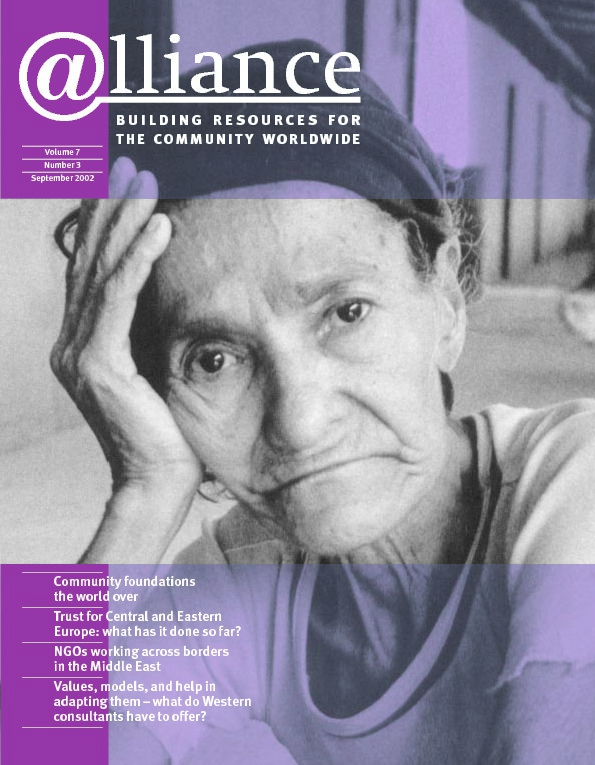Double-take. Look carefully at community foundations in the UK – they are not quite the same as in the US. While widely welcomed here, community foundations have taken time to bed in. The culture and structures of daily life are different from the US, where community foundations (CFs) first developed. Some of these differences have made it necessary to foster a culture of local giving.
CFs were born early in the last century in North America within a tradition of self-sufficient, well-defined communities in a decentralized country. On one of my first visits to a CF in the US, I walked into an entrance filled with photographs of donors and supporters – a good number of them long dead – and the sense of overt, local pride was tangible. These were all people who had been encouraged, over several generations, to contribute assets towards supporting and protecting a community they strongly identified with. They were not just thinking about what would help today, they were planning for a future beyond their lifetimes.
Challenges to local giving
In the UK, our centralized system and pattern of impulsive giving to national or international causes have not favoured a culture of local giving. Today’s increasingly transient population exacerbates this issue. I have lived in many different places in the UK and abroad, but find it hard to know which community I really belong to.
‘The other problem,’ a CF staff person confessed to me, ‘is that some of our potential supporters don’t want to see themselves as local figures – they want to be viewed as national players, and getting them to identify locally isn’t always easy.’ In the US, by contrast, CFs and their boards are viewed as the place to present your social calling card. A US CF executive once told me she had almost 200 names of people who had expressed an interest in becoming a board member.
The initial brave hearts who took to the CF concept had also to tackle another very British characteristic – the preference of many donors for giving anonymously, which thus robs the foundation of opportunities to offer real-life role models to encourage others.
Time, and experience, change behaviour
Despite these challenges, we are seeing change. As the number and profile of CFs rise, so do the numbers of donors who are giving through CFs precisely because their contribution is going to stay local. It has required a leap of faith, an appeal to parochialism, and time for CFs to establish and prove themselves. CFs now offer donors the choice of giving locally. The possibility of donations going into a local fund rather than simply dropping into ‘a big hole in the centre’ appeals to many.
One UK CF has recently received a large gift of shares from an individual via an investment company. In discussions with their money-managers, the donor realized it made sense to set up a permanent fund within the CF rather than set up his/her own charitable trust, and that the funds will stay close to home. This story is becoming more and more common.
Relationships with other sectors
Corporate giving is another area where UK CFs have progressed very differently from those in the US. A high proportion of CF funding in the US comes from individuals. In the UK, there is much more of a mix of donors. A growing number of companies are using CFs to do their local charitable giving, particularly by establishing named funds. For them, local profile for their company giving is important, and they can achieve this through the CF.
The attitude in the US is different, where responsibility is often placed with the individual. A leading US CF expert explained: ‘Corporations in the US see it as their role to make profits for their shareholders – it’s then up to the individuals the company makes wealthy to do the charitable giving.’
The UK has also seen examples of government bodies investing in the future of localities through contributions to CFs. These have included grants for operating costs in the early years of several CFs and a number of substantial donations forming exit strategies after years of investment by government in area regeneration. To mark the new millennium, one county council has established an endowed fund with a CF that supports a range of community activities.
Re-granting funding also flows from statutory sources to CFs. Increasingly, CF expertise as grantmakers has led to their being asked by a variety of donors to handle ‘pass through’ grants programmes. The most substantial example is a £70 million programme over three years from the government Children and Young People’s Unit: throughout England CFs have been commissioned to run a small grants programmes addressing poverty affecting children and young people.
The impact of this mix of funding, and the focus on local communities, is to reinforce close cross-sector working relationships, which are reflected on the boards and subcommittees of UK CFs.
Clare Brooks is Assistant Director – Network Services at Community Foundation Network. She can be contacted at cbrooks@communityfoundations.org.uk
For more information about CFN, visit the website at http://www.communityfoundations.org.uk or contact network@communityfoundations.org.uk





Comments (0)